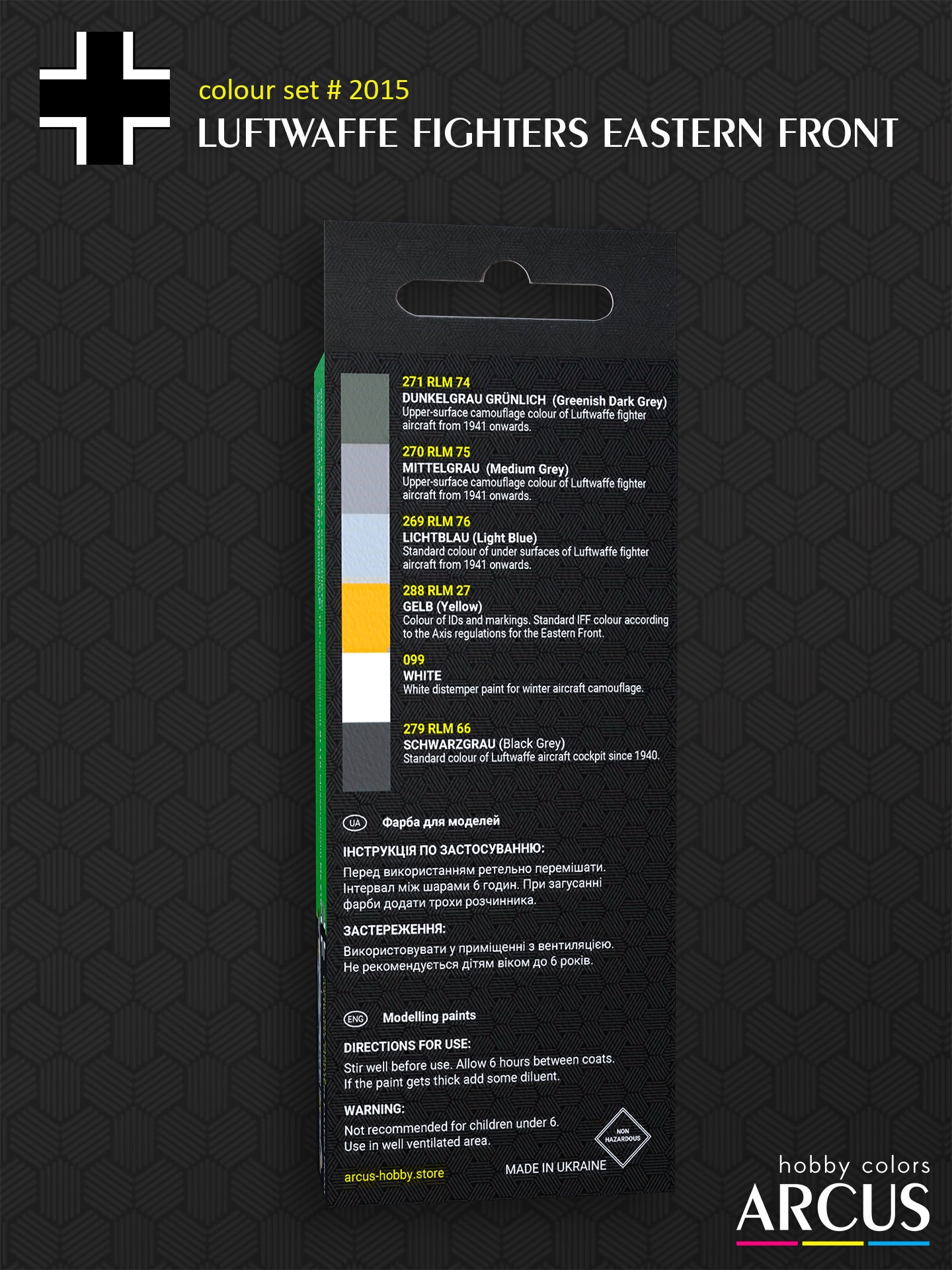Arcus Hobby
Paint Set 2015 Luftwaffe Fighters Eastern Front
无法加载取货服务可用情况
Luftwaffe Fighters, Eastern Front
During World War II, the Eastern Front witnessed intense aerial combat between the German Luftwaffe and the Soviet Air Force. The Luftwaffe deployed a formidable array of fighter aircraft to assert air superiority over the vast expanses of the Eastern Front. Among these, the Messerschmitt Bf 109, Focke-Wulf Fw 190, and the versatile Messerschmitt Bf 110 played pivotal roles in shaping the aerial landscape.
The Messerschmitt Bf 109, an iconic German fighter, proved its mettle on the Eastern Front. With its sleek design and powerful engine, the Bf 109 was a formidable adversary for Soviet aircraft. It excelled in dogfights and provided crucial air support for German ground forces. The harsh winter conditions of the Eastern Front posed unique challenges for both man and machine, and the Bf 109 demonstrated its adaptability in these harsh environments.
The Focke-Wulf Fw 190, introduced later in the war, further bolstered the Luftwaffe's presence on the Eastern Front. Renowned for its robust construction and impressive firepower, the Fw 190 was well-suited for ground-attack missions. It played a crucial role in supporting German ground forces, providing close air support in coordination with the Wehrmacht's operations.
The Messerschmitt Bf 110, despite initial roles as a heavy fighter and bomber escort, found its niche in ground-attack missions on the Eastern Front. Equipped with heavy weaponry, including cannons and bombs, it proved effective in striking Soviet ground targets. The Bf 110's adaptability and firepower made it a valuable asset in supporting German ground forces.
On the opposing side, the Soviet Union deployed a variety of fighter planes to counter the Luftwaffe threat. Among them, the Lavochkin La-5 emerged as a formidable opponent. Powered by the robust M-82 radial engine, the La-5 demonstrated agility and firepower, proving effective against German aircraft. Additionally, the Polikarpov I-16, though becoming outdated, played a role in the early stages of the Eastern Front. Its nimble design and agility were notable, even though it faced challenges against more advanced German planes.
The Eastern Front became a theater of ever-evolving aerial warfare, with both sides continually adapting their strategies and technologies. The legacy of these aircraft remains a testament to the complexities and challenges faced by aviators during this pivotal chapter of aviation history.
Use Guide for the Set Luftwaffe Fighters Eastern Front
- In 1941, a new camouflage scheme was introduced for Luftwaffe fighters. This camouflage involved the use of the two gray colors RLM 74 Dunkelgrau and RLM 75 Mittelgrau over the blue undersides of RLM 76 Hellblau.
- To avoid friendly fire, the Germans used yellow IFF elements on the aircraft, painted with RLM 27 Gelb like all Axis aircraft. This included the wingtips' undersides, fuselage bands, and sometimes the lower surfaces of the engine nacelles.
- During the winter of 1941 and 1942, while fighting in the USSR, due to snowy weather conditions, the Germans used temporary white winter paint to camouflage aircraft.
Set Luftwaffe Fighters Eastern Front Includes:
- 271 RLM 74 Dunkelgrau Grünlich (Dark Gray Greenish) - A dark gray camouflage color of the upper surfaces.
- 270 RLM 75 Mittelgrau (Medium Grey) - A light gray camouflage color of the upper surfaces.
- 269 RLM 76 Lichtblau (Light Blue) - A light blue color of the lower surfaces.
- 288 RLM 27 Gelb (Yellow) - A yellow ID color used for painting the fuselage bands, wing tips, etc.
- 099 White - A white washable paint used for temporary winter camouflage.
- 279 RLM 66 Schwarzgrau (Black Grey) - A dark gray cockpit color of German aircraft.
Collection:
This Set is Best for:
- Focke-Wulf Fw 190
- Messerschmitt Bf 109
- Messerschmitt Bf 110
- Messerschmitt Me 210
- Messerschmitt Me 410 "Hornisse", etc.
Paint Type:
- Acrylic A2015
- Enamel E2015
Paint Finish:
- Semi-gloss
Capacity:
- 6 x 10 ml. (6 x 0.33oz)





